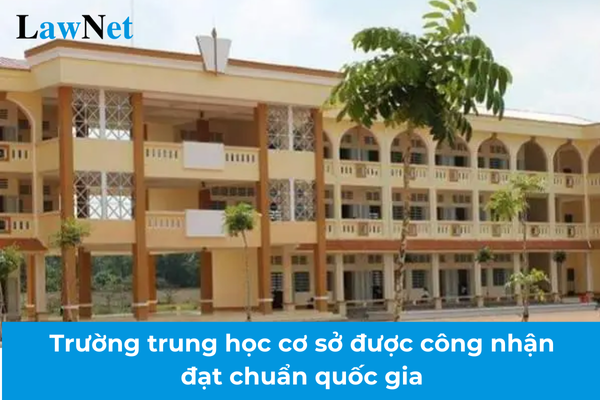What are the conditions for a lower secondary school to be recognized as a national standard school in Vietnam?
What are the conditions for a lower secondary school to be recognized as a national standard school in Vietnam?
Under Article 37 of the Regulations on education quality accreditation and recognition of conformity with national standards for lower secondary schools, upper secondary schools and multilevel education institutions issued together with Circular 18/2018/TT-BGDDT, the conditions for a lower secondary school to be recognized as a national standard school in Vietnam are as follows:
Recognition of conformity with national standards
1. Recognition conditions:
A secondary school is granted the recognition of conformity with national standards if they meet regulations laid down in point a of clause 1 of Article 34 and achieves external assessment results stating that they have conquered Level 2 or more as prescribed in clause 1 of Article 6 herein.
2. Recognition level:
a) Level 1: The assessed school conquers Level 2 prescribed in clause 1 of Article 6 herein;
b) Level 2: The assessed school conquers Level 3 or more as prescribed in clause 1 of Article 6 herein.
Thus, a lower secondary school is recognized as a national standard school when it meets the following conditions:
- For Level 1 national standard school:
+ For newly established schools, they must have operated for at least 5 years and have had at least one cohort of students complete the lower secondary education program. For schools established by merger or division, they must have operated for at least 2 years.
+ They are assessed at Level 2 according to the provisions in clause 1, Article 6 of the Regulation issued together with Circular 18/2018/TT-BGDDT.
- For Level 2 national standard school:
+ For newly established schools, they must have operated for at least 5 years and have had at least one cohort of students complete the lower secondary education program. For schools established by merger or division, they must have operated for at least 2 years.
+ They are assessed at Level 3 according to the provisions in clause 1, Article 6 of the Regulation issued together with Circular 18/2018/TT-BGDDT.

What are the conditions for a lower secondary school to be recognized as a national standard school in Vietnam? (Image from the Internet)
What is the process for recognition of conformity with national standards for lower secondary schools in Vietnam?
Under Article 4 of the Regulation on educational quality accreditation and national standard recognition applicable to lower secondary schools, high schools, and schools with multiple educational levels issued together with Circular 18/2018/TT-BGDDT, the process for recognition of conformity with national standards for lower secondary schools shall be carried out by going through the following steps:
- Self-assessment.
- External assessment.
- Recognition that the school passes the education quality accreditation, and recognition that the school conforms to national standards.
What is the process for the self-assessment of a lower secondary school in Vietnam?
Under Article 23 of the Regulation on educational quality accreditation and national standard recognition applicable to lower secondary schools, high schools, and schools with multiple educational levels issued together with Circular 18/2018/TT-BGDDT, the self-assessment of a lower secondary school shall go through the following steps:
- Establishing a self-assessment committee.
- Coming up with a self-assessment plan.
- Collecting, processing and analyzing evidence.
- Determining the level that can be achieved based on corresponding benchmarks.
- Preparing a written self-assessment report.
- Announcing the self-assessment report.
- Conducting activities after the self-assessment report is completed.
What are the duties and powers of the self-assessment committee?
Pursuant to Article 25 of the Regulation on educational quality accreditation and national standard recognition applicable to lower secondary schools, high schools, and schools with multiple educational levels issued together with Circular 18/2018/TT-BGDDT, the duties and powers of the self-assessment committee are prescribed as follows:
1. Duties
- The committee’s chairperson administers activities of the committee, assigning duties to each member; approving the self-assessment plan; establishing a secretariat and working groups to conduct self-assessment; directing the process of collecting, processing and analyzing evidence; completing a self-assessment report; solving problems that may arise during the period of self-assessment;
- The committee’s vice chairperson performs the duties assigned by the chairperson and administers the committee when being authorized by the chairperson;
- The committee’s secretary and other members perform the tasks assigned by the chairperson and are held responsible for their assigned tasks.
2. Powers
- Carrying out self-assessment activities and counseling the principal on measures to maintain and improve the quality of the school’s activities;
- Formulating a self-assessment plan; collecting, processing and analyzing evidence; preparing a self-assessment report; revising the self-assessment report as requested by the direct supervisory authority; announcing the self-assessment report; maintaining the school’s self-assessment database.
- The committee can suggest hiring of counselors who can assist the committee in conducting self-assessment to the principal. Counselors must have deep insights about quality assessment and self-assessment techniques.

